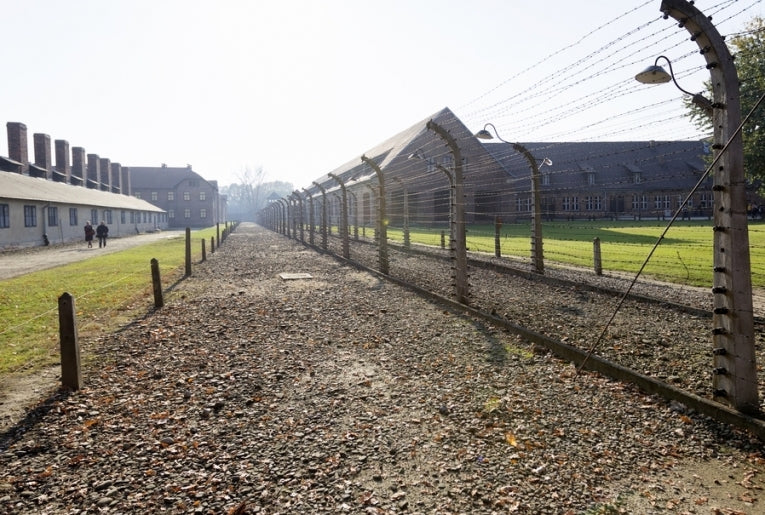On 27th January 1945 advancing Soviet troops liberated the Nazi death camp at Auschwitz-Birkenau in Upper Silesia.
Auschwitz was the largest of the German concentration camps and was in fact a major complex consisting of a base camp, an extermination camp, a labour camp and 45 satellite camps.
Reichchsfà ¼rer Heinrich Himmler designated Auschwitz II-Birkenau as the extermination camp, making it "the final solution of the Jewish question in Europe". From 1942 until late 1944 a highly organised rail network brought daily deliveries of Jews and other "undesirables" to the camp from all corners of German-occupied territory.
Among the prisoners were a number of talented musicians and it is well documented that the SS created several orchestras and forced them to play jolly music as the new prisoners were unloaded from the goods wagons that had brought them to the camp.
The new prisoners went though a selection process. Around a quarter were picked out as being suitable to join the labour force, but the remainder, including almost all the children, the women with children, the elderly and those who did not appear to be completely fit, were taken together and told that they were to have a shower before being admitted to the camp.
They new arrivals undressed in an outer room before entering what appeared to be a shower room. This was actually a gas chamber and once the doors had been shut, cyanide gas was introduced through holes in the roof.
Although death was not instant, after about 20 minutes everyone would be dead and "trustee" prisoners known as Sonderkommandos entered the room to remove any gold from the teeth and transfer the corpses to the adjacent crematoria.
The efficiency of the operation can be gauged from the fact that it was possible for more than 20,000 people to be gassed and cremated every day, but by mid-1944 even this was not enough. By then the Nazis had begun to deport the Hungarian Jews to Auschwitz and the volume of new arrivals became so great that the crematoria could no longer cope with the demand and the SS had to resort to burning corpses in open-air pits.
In 1945, as the Red Army advanced, the situation became chaotic. Himmler ordered the destruction of the crematoria and gas chambers in an attempt of hide the crimes at Auschwitz and orders were also issued to destroy all records. On 17th January a further order was issued to execute all the prisoners, but due to the chaos of the Nazi retreat this last order was never carried out.
Instead it was decided to evacuate the camp and nearly 60,000 prisoners were forced on a death march. The 7,500 prisoners who were too weak or sick, were left behind and ten days later on 27thJanuary the Red Army liberated them.
Eventually around 20,000 prisoners managed to reach the concentration camp at Bergen-Belsen in Lower Saxony, which was liberated on 15th April 1945 by British and Canadian troops. They discovered 53,000 prisoners in the camp, most of whom were half-starved and seriously ill. In addition there were some 13,000 unburied corpses lying around the camp. The BBC war correspondent, Richard Dimbleby, who was accompanying the British liberators, described the day as "the most horrible of my life".
Sadly, after liberation, a further 13,994 former Bergen-Belsen inmates died either as a result of disease or because their long-term starvation had weakened their digestive systems and they could not tolerate proper food.
Precise figures of deaths in the camps are difficult to come by, largely due to the fact that the SS made every attempt to destroy all records in order to cover up any evidence of atrocity. The officially estimated death toll for the extermination camp at Auschwitz, according to the Auschwitz State Museum, is 1.1 million.
The death toll at Bergen-Belsen was lower because it was not a designated extermination camp, but even so, somewhere in excess of 50,000 prisoners are thought to have died as a result of maltreatment and disease
The Nazi extermination programme in World War II was one of industrial proportions and its sheer scale certainly warrants the use of the term Holocaust. The total number of deaths resulting from atrocities by the Nazi regime and its collaborators is put at around 6 million Jews, together with around 2 million Gypsies, some 15,000 homosexuals and countless others who were members of further groups that were considered to be undesirable.
It was on 27th January 2001 that the United Kingdom first began to observe a commemoration day for what by then had become known as the Holocaust. In January 2005, the 60th anniversary of the liberation of the Nazi concentration camps was marked by a special session of the UN General Assembly. In November the same year the UN General Assembly formally adopted Resolution 60/7 that established 27th January as International Holocaust Remembrance Day.
This special day has two important features. The first deals with the memory and remembrance of the millions of men, women and children who met untimely deaths during the Holocaust.
Allied to this is an educational programme that includes the active preservation of the sites of death camps, concentration camps, forced labour camps and prisons that sets out to provide a lasting reminder to future generations of the horrors that can happen in an unfettered political system.
Such atrocities can never be allowed to happen again.










